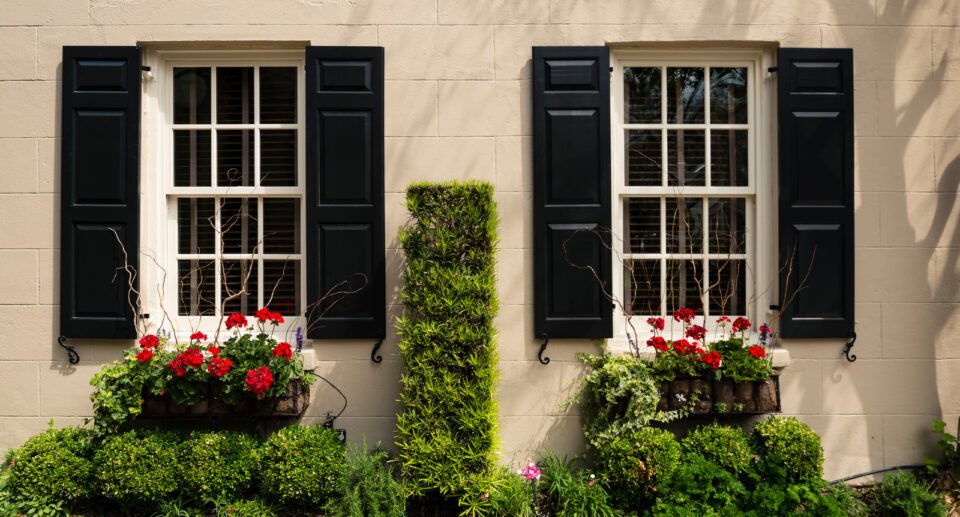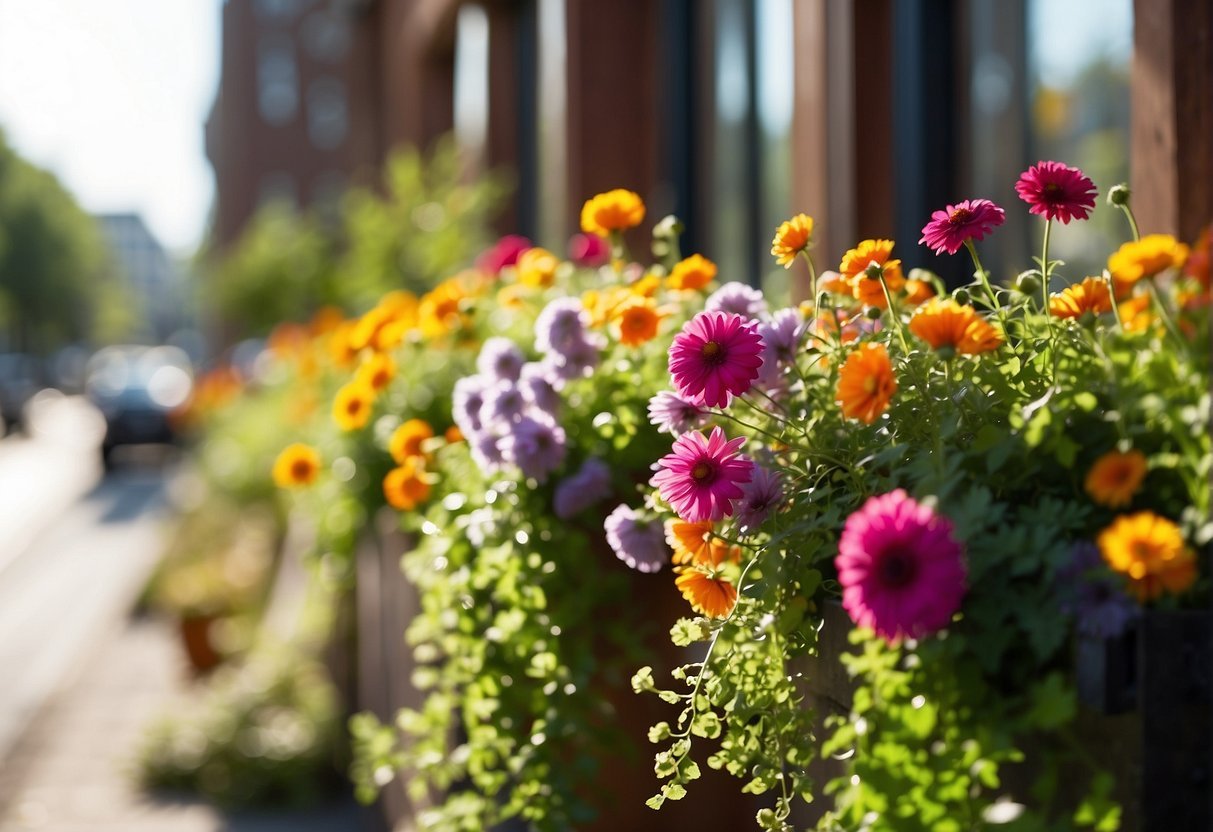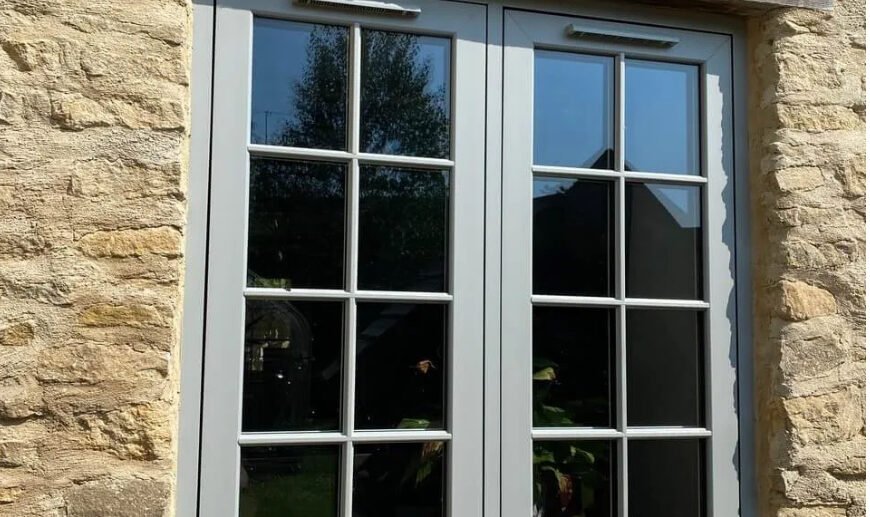Best Window Boxes: Top Choices for Your Home Garden Display

Table of Contents
ToggleWindow boxes are an enchanting addition to any home. They provide a splash of greenery and colour that can transform the façade of a building. Whether for a small city flat or a country house, they offer a space-saving solution to grow plants, herbs, or flowers.

Selecting the best window box involves consideration of aesthetics, functionality, and the specific needs of the plants you wish to cultivate.
Careful choice of materials and size will ensure longevity and suitability for the environment they will inhabit. For example, materials like resin can withstand the elements, while the size should correspond with the window’s dimensions and the root requirements of the plants.
Installation requires attention to detail, ensuring the boxes are securely mounted while allowing for proper drainage to prevent waterlog and root rot.
Key Takeaways
- Window boxes enhance homes with natural beauty and are suited for various living spaces.
- Material and size selection are crucial for the window box’s durability and the plants’ growth.
- Proper installation and drainage are essential to maintain the health of window box plants.
Understanding Window Boxes

In this section, the reader will explore the cultural importance, design considerations, and material trade-offs associated with window boxes.
Historical Significance
Window boxes have a storied past, illustrating not only utilitarian function but also social and architectural trends. Initially practical spaces for growing herbs and vegetables, they have since morphed into symbols of style and domestic charm. In Europe, particularly in the UK, window boxes have been a prominent feature of urban and rural homes for centuries, marking a confluence of practicality and ornamentation.
Design and Aesthetic Value
The visual appeal of a window box hinges on both its compatibility with the window itself and the architecture of the building. They are commonly the same width as the window, fostering a harmonious look, although variations exist to accentuate other architectural features such as shutters or trim. The design method often involves three types of plants:
- Thrillers: Tall, eye-catching plants placed centrally.
- Spillers: Plants that drape over the edges to soften the appearance.
- Fillers: Plants used to fill gaps, adding fullness and colour.
Material Pros and Cons
Window boxes are crafted from a range of materials, each with its own set of advantages and challenges.
| Material | Pros | Cons |
|---|---|---|
| Wood | Aesthetically warm; insulates roots; repairable | Can rot; may need regular maintenance |
| Metal | Durable; sleek designs | Can rust; may heat up, affecting plant roots |
| Plastic | Lightweight; resists rust and rot | May crack with UV exposure; less eco-friendly |
One’s choice will depend on the desired style, durability requirements, and the climate. It’s important to consider the material’s reaction to the elements, such as wood’s tendency to rot or metal’s propensity to rust, and weigh these against aesthetic preferences and the ability to sustain the health of the plants.
Selecting the Right Size and Material

Selecting the ideal size and material for window boxes is crucial to ensure they complement your home aesthetically and endure through various weather conditions.
Size Matters
The size of a window box should match the window it accompanies. It ought to be no wider than the window itself for an elegant look. Here are specifics:
- Optimal Length: The length should be within 2.5 cm of the window’s width.
- Depth and Height: They should be sufficient to accommodate the root systems of your chosen plants, typically between 15 cm and 30 cm.
Material Choices
The material of the window box greatly influences its appearance and longevity.
- Wood: Offers traditional charm, suitable for painting, but may require regular maintenance.
- Metal: Durable and often heavy; materials like tin are cheaper but may rust.
- Plastic: Lightweight, fade-resistant, and generally more affordable.
- Fibreglass: Mimics other materials, durable and lightweight.
Durability and Maintenance
Longevity and upkeep are important considerations for window box selection.
- Wood: Requires treating to resist weather, prone to rot if not maintained.
- Metal (e.g., tin): Can corrode without proper treatment.
- Plastic: Resistant to weather and low-maintenance, but less environmentally friendly.
- Weather-resistant coatings: Can enhance durability of less hardy materials.
Installation and Mounting

When installing window boxes, the crucial aspects to consider are the method of mounting and ensuring that the installation promotes safety and maintains stability. The type of window, the surface onto which the box is being affixed, and the weight of the box when filled are all pivotal factors.
Step-by-Step Mounting Guide
- Measuring: One must measure the width of the window to ascertain the correct size of the window box. It should complement the window aesthetically and fit securely.
- Marking Location:
- Use a pencil and measuring tape to mark approximately 2.5 cm from the bottom of the window ledge.
- Ensure that the marks are directly in line with the window frame for symmetry.
- Brackets Installation:
- Window boxes typically require the use of strong mounting brackets affixed directly to the wall, fence, or balcony.
- The top of the bracket should align with the marks made earlier.
- Attaching the Box:
- Place the window box onto the brackets and secure it.
- It should sit evenly and not tip forward or backward.
Safety and Stability
- Selection of Brackets: Choose robust mounting brackets that can support the weight of the box and its contents when fully watered.
- Securing Firmly: Fasten the brackets to the wall or whichever surface is being used, ensuring that they are tightly fixed to prevent any movement.
- Regular Inspection: Periodically check the mounting to ensure that it has not loosened over time, which is essential for long-term safety and the continued stability of the window box.
Best Plants for Window Boxes

Selecting the right plants for window boxes can enhance the aesthetics of one’s home while optimising the use of space. Plants suited for such arrangements include a mix of flowers, herbs, and vegetables, tailored to provide visual appeal and practical use throughout the seasons.
Floral Arrangements
For a vibrant display of colour, annual flowers like petunias and marigolds are excellent choices. Petunias offer a rich palette of hues and flourish with regular watering and full sunlight. Marigolds are valued for their bright orange and yellow blossoms which can add a cheerful contrast to green foliage. Geraniums are also popular for their robust nature and variety of colours. To add a cascading effect, one might consider incorporating honeysuckle or trailing varieties of snapdragons. For shady areas, ferns can provide lush greenery and work well in combination with other shade-tolerant flowers.
Herbal Delights
Herbs not only contribute fragrance and greenery, but are also practical for culinary use. Sage is a hardy herb with aromatic leaves, perfect for a sunny window box. It pairs nicely with other robust herbs such as rosemary and thyme. For softer foliage and quick kitchen access, planting lettuce varieties can be beneficial as they can be harvested as needed. Herbs generally require well-drained soil and a fair amount of sunlight to thrive.
Vegetable Patches
Window boxes need not be limited to ornamental plants. Tomatoes are a splendid choice for a sunny ledge, with miniature or “patio” varieties adapting well to the confined space. It’s important to support the plants as they grow and ensure they have sufficient room for air circulation. Similarly, lettuces offer a practical vegetable option that can be easily grown and cut for fresh salads. They prefer cooler conditions and should be watered consistently.
Watering and Drainage Solutions
When considering window box gardening, ensuring that your plants receive the correct amount of water and that excess water can escape is crucial. An effective drainage system paired with proper watering techniques can protect plants from waterlogging, while self-watering innovations offer convenience and efficiency.
Effective Drainage Systems
For healthy plant growth, window boxes must have effective drainage to prevent water from pooling. Drainage holes at the bottom of the box are essential; they allow excess water to escape, which prevents root rot and other water-related diseases. To enhance drainage, one might consider adding a layer of gravel or broken pottery at the bottom of the window box before filling it with soil.
Watering Techniques
Watering appropriately is key to plant vitality. Plants in window boxes should be watered until water runs out of the drainage holes, indicating that the soil is fully saturated. For outdoor boxes, checking the soil moisture before watering can prevent over-watering. During warmer months, this may mean daily watering, especially if the window box is in direct sunlight.
| Weather Conditions | Watering Frequency |
|---|---|
| Sunny and hot | Daily |
| Overcast | Every 2-3 days |
| Rainy | As needed |
Self-Watering Innovations
Self-watering planters are a modern solution that ensures plants receive the water they need with minimal maintenance. These planters typically feature a reservoir that stores water, reducing the frequency of watering.
Water is drawn up into the soil via a wicking system or allowed to seep in through openings in the planter as necessary. A self-watering feature promotes consistent moisture levels, ideal for busy individuals or for use in difficult-to-reach window boxes.
Caring for Your Window Boxes
Proper maintenance of window boxes ensures they remain vibrant and prolongs the lifespan of the plants within.
Routine Maintenance
Regular upkeep of window boxes is vital.
Gardeners should water the plants daily, especially during dry periods, as window boxes tend to dry out faster than garden beds.
Utilising a balanced fertiliser bi-weekly can provide essential nutrients.
It’s also important to consistently deadhead spent flowers to encourage new growth and to remove any wilted or diseased foliage to prevent the spread of plant diseases.
- Watering: Aim for consistent moisture without waterlogging.
- Fertilising: Use a balanced liquid fertiliser every two weeks.
- Pruning: Deadhead and trim regularly for optimal plant health.
Seasonal Adjustments
Plants in window boxes can suffer from extreme weather, so gardeners should make seasonal adjustments to protect them.
During the hot summer months, plants may need shade during peak sun exposure, particularly if they’re not suited to full sun.
Conversely, in winter, plants may benefit from insulation against the cold, and gardeners might consider seasonal species that tolerate lower temperatures.
- Summer: Provide afternoon shade for plants that can’t tolerate full sun.
- Winter: Swap out tender plants for hardy varieties; consider insulating the window box.
Longevity Tips
Ensuring the longevity of window boxes involves a mix of material choice and seasonal compost refreshment.
Selecting durable materials like resin can prevent premature degradation, while adding fresh compost annually improves soil structure and nutrition.
For wooden boxes, gardeners may apply a non-toxic sealant to protect against rot and weathering.
- Materials: Choose durable, weather-resistant materials.
- Compost: Refresh with new compost at least once a year to replenish nutrients.
Accessorising Your Window Boxes
Accessorising window boxes can transform the external appearance of a home by adding charm and character. It involves more than just selecting plants; it’s about enhancing the aesthetic appeal through additional decorative elements and support accessories.
Adding Decorative Touches
Decorative touches to window boxes can include a variety of elements such as liners and troughs that serve both practical and aesthetic purposes.
A plastic liner is essential for protecting the container and extending its lifespan. It can be concealed under the soil or flaunted for its design, depending on the desired look.
For a more rustic appeal, options such as ceramic, copper, or terracotta liners are popular choices that add a sophisticated edge to the arrangement.
Furthermore, the inclusion of a window basket made from wire or woven materials can create an appealing contrast against the foliage.
- Liner Materials:
- Plastic: Practical, waterproof
- Ceramic: Stylish, heavy-duty
- Copper: Long-lasting shine, antimicrobial properties
- Terracotta: Classic look, porous for root health
Support Accessories
Window boxes require solid support to ensure safety and stability.
Metal brackets are commonly used for this purpose as they provide a reliable foundation for any planter box—whether it’s made of lightweight materials like plastic or heavier ones like wood.
The design and colour of these brackets can be chosen to complement the container, subtly blending in or acting as an additional decorative feature.
It is essential to ensure that the chosen support can bear the weight of the box when filled with soil and plants, thus preventing any accidents.
- Support Options:
- Metal Brackets: Strong, various designs available
- Weight Considerations: Must be suitable for the box’s total filled weight
Value Considerations
When selecting window boxes, consumers often weigh the initial cost against longevity and aesthetic appeal. A prudent choice balances budget constraints with the desired quality.
Budget-Friendly Picks
For shoppers seeking value for money, there are window boxes that offer durability without a hefty price tag. For instance:
- Classic Home and Garden Corinthian Trough Planter: Priced at around £17, this is a cost-effective option available on Amazon.
- HC Companies Outdoor Plastic Railing Planter Box: With prices starting from roughly £28, it caters to those who want to add charm to their railings affordably.
Splurge-Worthy Investments
Customers who favour premium qualities and are prepared to invest more might consider:
- Mayne Fairfield Window Box: It commands a higher price, approximately £108, but its reputation for superior build and an inclusive water reservoir justifies the expense.
Frequently Asked Questions
When selecting the best options for window boxes, garden enthusiasts frequently inquire about plant types, materials, and designs that work well throughout various seasons and conditions. These common questions receive straightforward answers below, providing clarity and guidance.
Hearty evergreens and resilient perennials such as ivy, cyclamen, and dwarf conifers maintain their appearance throughout the year, offering a long-lasting display for window boxes.
Plants like petunias, geraniums, and marigolds are excellent choices for window boxes in full sun. They are known for their ability to thrive in bright conditions and provide vibrant colours throughout the blooming season.
One should look for materials that are rot-resistant and strong, such as treated wood, fibreglass, or high-quality plastics. These materials ensure durability and long-term performance against the elements.
Contemporary window box designs often feature clean lines and minimalistic aesthetics. Materials like stainless steel, galvanised metal, or sleek composites can complement a modern design theme.
Vertical gardens, hanging baskets, and repurposed items such as old crates or pallets can serve as inventive alternatives to conventional window boxes, adding a unique touch to exterior spaces.
A depth of at least 20–25 centimetres is ideal for a window box. This depth gives sufficient space for root growth and moisture retention. Both are crucial for the plants’ health and stability.

Hello, I’m Keith Jones. I’m the author and head of content here of door and window guide. I’ve been in the window and door industry for over 10 years in the UK and North America. I’ve had quite a few roles during my career mainly in Worldwide sales. I’m now semi retired so I thought I’d put my knowledge to good use educating people about all they might need to know about door and window related topics.






